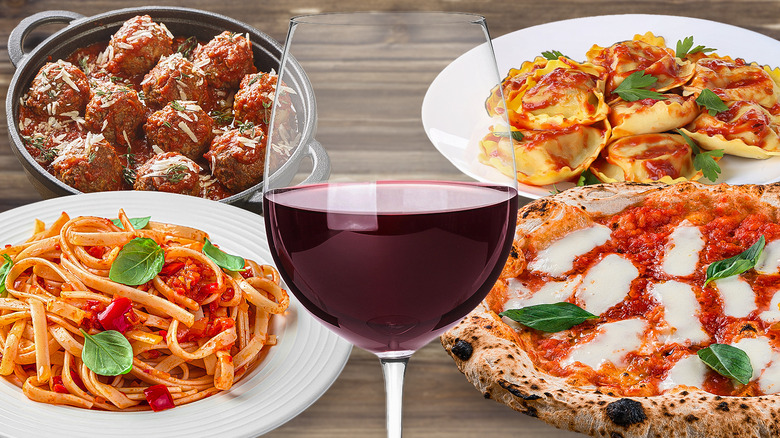The Best Types Of Italian Wine To Pair With Tomato Sauce Dishes, According To An Expert
Wine and tomatoes are two of life's great pleasures, so aren't we so lucky they go so well together? A big plate of pasta with tomato sauce and a bottle of wine is the dictionary definition of good Italian eating. But when it comes to the specifics of the wine, you might not be so confident. Most people already lack confidence when it comes to pairing wine and food given how much there is to learn, but Italian wine presents their own set of problems because Italy has a very regional wine industry that produces styles unfamiliar to the average American. You know pinot noir and cabernet sauvignon, but how does that translate to nero d'avola or montepulciano? To help us out with this, Tasting Table connected with Nathan Grunow, the wine director at Jovanina's Broken Italian, for his advice on how to pair Italian wines with tomato sauce.
Like with spice and other bold flavors, Grunow says the key is finding a wine and sauce that can go toe-to-toe. "The two big things we think about are the sweetness and high acidity level of the tomatoes. The general rule of thumb is that you want to try to match the acidity level of the sauce," he told us, adding that he gravitates to varietals like Sangiovese, which is the primary grape in the Chianti blend, due to their bright, fresh qualities that complement most red sauces.
Choose a bold, acidic style from a dish's home region
Grunow says another great trick for wine and tomato sauce is learning where different types of wine come from. He says, "While tomatoes are grown throughout Italy, we've found that no one is quite as parochial about their tomatoes as Sicilians." He recommended wines from Sicily's Mt. Etna region, especially the reds with a high percentage of Nerello Mascalese grapes. How can you tell when you're getting wine from this area? Look out for labels with the term "Etna Rosso." Finally, one more interesting pairing Grunow recommends is Sicilian red blends, particularly ones that use Sicily's famous varietal Nero d'Avola, which he calls "dark fruited," and another local grape called Frappato, which balances out the blend with a bright fruity acidity.
While the strength of acidity in the wines you are sipping with tomato sauce is important, Grunow also notes that there are broad ranges of taste that can work, explaining, "We've had more success recently with wines that, while at least minimally acidic, also give great earthy counterpoints to add to the tasting experiences." So while exploring the world of Italian wines can be overwhelming, learning just a few handy benchmarks about styles and Italy's tomato-growing regions ensures that you'll end up happy with your pairing.

